Ford takes another swipe at the full-size SUV segment with the all-new Everest that sees more than just cosmetic changes
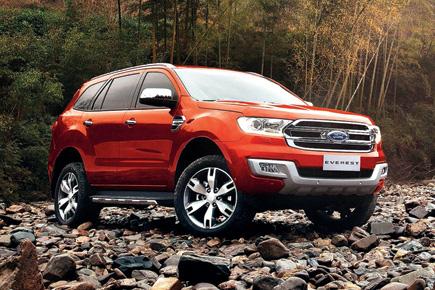
SUV
ADVERTISEMENT
The SUV segment is one that car manufacturers selling in India can ignore only at their peril. Ford, the marquee sporting the famed blue oval, did not pass by this segment either and, well before the EcoSport, there was the Endeavour, sold abroad as the Everest, which launched here in 2003.
The Endeavour had (and still has) its followers, but it has not had the kind of success the company would have liked. Ford has been testing the new Everest, nee Endeavour, in recent months, and we were in Thailand to get a feel.
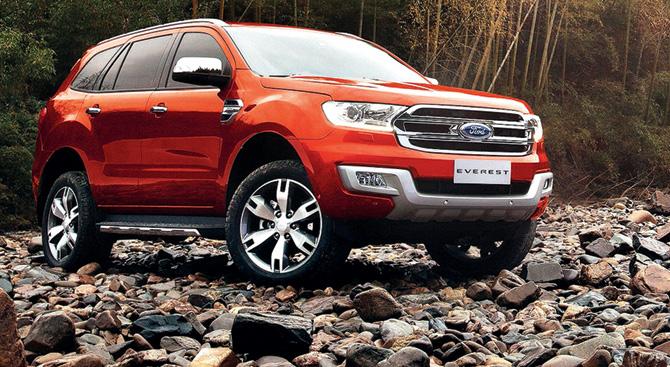
At first glance, the Everest looks more balanced in proportions. The boxy appearance has become slightly rounded, boosting its appeal for those who like something more graceful but holding on to fans of the butch, in-your-face looks of a “typical” SUV. The 20-inch alloys look impressive as do the projector headlamps with LED DRLs.
Inside, the Everest is a true seven-seater. The interior is plush, with a leather-like material covering the top of the dashboard, and the powered front seats allow you to customise your seat position. Ford claims sound deadening was a priority area, and there are three microphones for active noise cancellation and thus a quiet cabin.
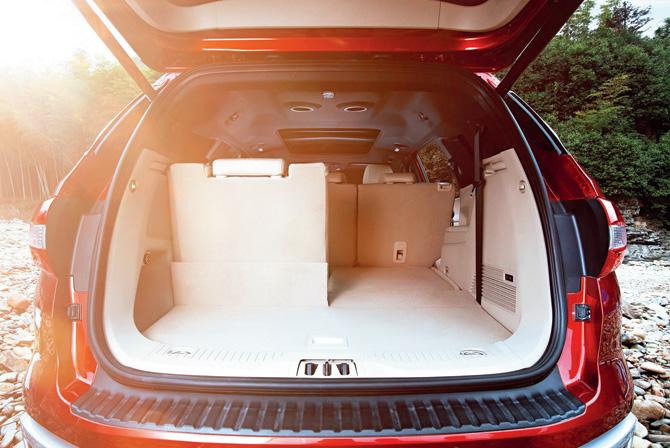
Boot space is flexible aided by power-folding third-row seats and flat-foldable second row. PICS/FORD INDIA
The in-car connectivity system, SYNC2, uses voice commands to control the entertainment system (comprising an eight-inch touchscreen with a 10-speaker sound system), climate controls and connected mobile devices. The dual-zone climate control system has HVAC vents in each row. The dual-panel moon-roof adds to the feeling of space by letting in more light, and you can also stick your head out, if you wish.
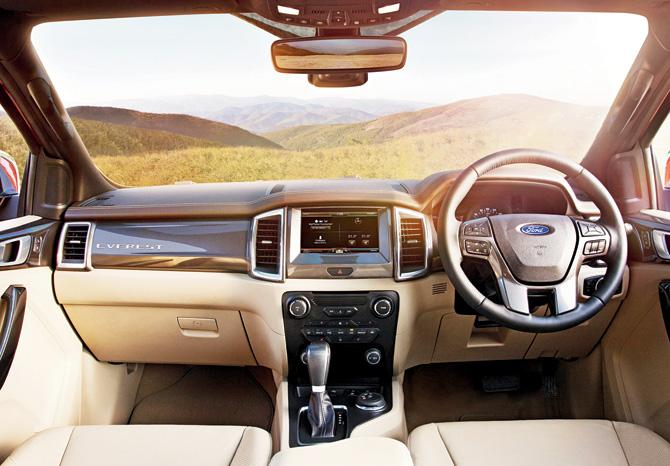
The powered front seats allow you to customise your seat position.
The Everest sports a segment-first power liftgate, that is, at the touch of a button it can be opened or closed for added convenience when accessing the boot. Boot space itself is flexible, aided by the segment-first power-folding third-row seats (50-50 split) and flat-foldable second row (60-40 split). With the second and third rows folded flat, you have a massive 2,010 litres at your disposal.
The Everest has a choice of two turbo-diesel power plants: a 2.2 litre four-cylinder with 160 PS and 385 Nm, and a 3.2 litre five-cylinder with 200 PS and 470 Nm. The 2.2 comes with a choice of six-speed manual and automatic transmissions as well as rear- or four-wheel drive, while the 3.2 has only the six-speed automatic and four-wheel drive.
On the road, the 3.2 feels powerful. Floor the pedal and the Everest rushes forward with an eagerness belying its size. Comparatively, the 2.2 feels sluggish (we drove only the six-speed automatic variant), but it still has sufficient power to satisfy most buyers. The six-speed automatic transmission is not the fastest, yet works well, and can be used in manual mode for more spirited driving. A unique feature is the fact that over a distance of 100-200 km, the transmission adapts its performance to your driving style by considering acceleration and deceleration, braking and cornering.
The Everest uses independent coil-over-strut front suspension, with coil springs at the rear. The solid rear axle features a Watt’s linkage that is claimed to allow vertical movement of the axle with minimal lateral movement, thus letting engineers control steering and handling more tightly than the Panhard rod system. The end result is a smooth ride over most surfaces and body-roll that is well controlled.
Safety has not been ignored. Key aids include seven airbags (front, side, curtain and knee), curve control (adjusts engine torque and four-wheel braking if you enter a corner too quickly), hill launch assist, electronic stability control and a blind-spot information system. The Active Park Assist facilitates parallel parking by using the electric power-assisted steering to back into a spot. It requires the driver to only shift, brake and accelerate as directed.
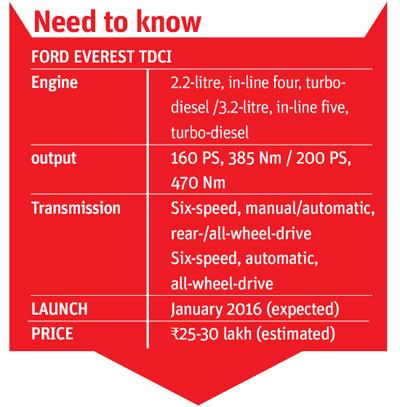
The Everest should impress off-roading enthusiasts with its ground clearance of 225 mm as well as water-wading capability of 800 mm, and departure, ramp-over and approach angles of 25, 21 and 29 degrees respectively. The Terrain Management System (TMS) offers a choice of normal, snow/mud/grass, sand and rock settings, as well as hill descent control, an Electronic Locking Rear Differential, and 4x4 Low, and this raft of options is more than enough to whet the appetite of even serious off-roaders looking for a competent SUV that is comfortable too. Indeed, on the varied off-road sections of the drive, there was not a stretch or obstacle that the Everest could not conquer.
Ford officials expect the Everest to be in the Indian market within six months, which should see it on our roads by the festive season this year. Specifications and performance are impressive, and, if Ford get the pricing right, it might just run away with the title of class-best SUV. Wait and watch.
 Subscribe today by clicking the link and stay updated with the latest news!" Click here!
Subscribe today by clicking the link and stay updated with the latest news!" Click here!







